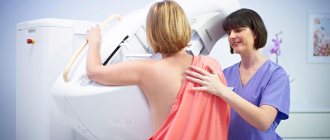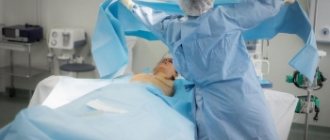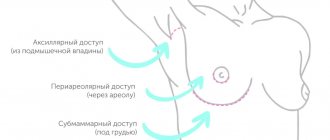Breast examination after mammoplasty is carried out for two purposes. The first is an assessment of the breast tissue and lymphatic system. The second is to check the condition of the implants and the body’s reaction to them.
Breast examination begins with a medical examination and palpation. After examination, the surgeon prescribes an ultrasound examination of the mammary glands. Breast ultrasound after mammoplasty has advantages over magnetic resonance imaging (MRI) and mammography.
Ultrasound is a reliable, safe research method with no contraindications. The cost of ultrasound is 4-5 times lower than MRI. The duration of ultrasound diagnostics is 15-20 minutes.
Examination of breasts with implants.
Many girls wonder how breast examination will proceed after breast augmentation. Will all examined breast areas be visible on the machines?
Every woman, of course, takes care of her health. And everyone knows that after 35 years you need to undergo a mammogram once a year. And even more so after breast augmentation. Fluorography is also carried out once a year.
We all want to be healthy and therefore girls who care about their future always undergo examinations on time.
So what will this look like? Do implants interfere with breast exams?
How to do an ultrasound after mammoplasty? How is fluorography performed with breast implants? CT and MRI after mammoplasty? Ultrasound after breast augmentation? We will help you figure it out.
We would like to note that the presence of breast implants does not affect the examination in any way; you can always establish an accurate diagnosis using one of the methods.
But of course, with the availability of modern technology for examining the breast after mammoplasty.
Modern clinics, as a rule, are equipped with the latest models of technology. When making an appointment at a clinic for an examination, a girl should clarify what devices are available, whether it is possible to conduct an examination in this clinic if she has breast implants, and of course, consult with a specialist to select the exact research method in an individual case.
And we will dispel existing myths about the impossibility of conducting an examination.
Ultrasound - ultrasound examination. After breast augmentation, it is performed annually. One of the most common examination methods in our time. It is also a mandatory examination before breast plastic surgery. Ultrasound of the mammary glands after breast augmentation allows you to identify pathologies of the mammary glands before surgery, assess the condition of the breast implants and the tissues themselves, and also exclude possible complications, such as inflammatory processes, tissue changes, and the formation of a capsule during the rehabilitation period.
Mammography after mammoplasty is the most thorough examination method. The mammography examination method after mammoplasty has minor difficulties. You need to know about this! The implant may block some areas of the mammary gland during the examination; to a greater extent and percentage, this applies to those cases when the implant is installed above the pectoral muscle. If the implant is installed under the muscle, the area of the breast covered is much smaller. Also, this research method is not informative in cases of ruptures or leakage of breast implants.
MRI after mammoplasty is a magnetic resonance imaging of the mammary glands.
A method for examining gland tissue using a powerful magnetic field. This method identifies tumor foci, metastases, and ruptures of breast implants.
CT or computed tomography after mammoplasty, this type is classified as X-ray methods for examining the breast. It is the most informative and accurate type of research for diagnosing cancer. CT scan is prescribed to clarify the diagnosis for a narrow circle of women.
FLG after mammoplasty or fluorography after breast augmentation.
Before undergoing this examination, the patient must notify the doctor about the presence of breast implants. Many people wonder whether implants are visible in the FLG image. We will also answer, yes, obviously.
As you can see, the silicone implants that are used for mammoplasty are permeable to X-rays, their presence will not complicate the examination of the lungs during FLG.
Let's summarize.
To examine the breast after mammoplasty, examinations (ultrasound, CT, MRI) are carried out to obtain the most accurate data, and the presence of implants does not interfere with these examinations. And also examination of the lungs with FLH can also be carried out without fear.
Be healthy and beautiful.
46602 March 24, 2015 Author: My Plastic Surgeon Rate this publication: Rating: 3.7777777777778 based on 9 votes
MRI of the mammary glands
Breast MRI is the most accurate method for breast diagnosis. Unlike mammography, it does not have radiation exposure. However - just for prevention, for everyone - it is not suitable because:
- in St. Petersburg there are only a few specialists who can describe MRI of the mammary glands
- High-quality MRI of the mammary glands cannot be done on any MRI machine.
- The research is expensive, the state does not pay for it, and patients look for something cheaper.
Due to the fact that it is difficult to provide all these components, overdiagnosis during preventive MRI of the mammary glands is observed in all countries of the world.
NB! At the First Medical University named after. I.P. Pavlova at st. Lev Tolstoy 17 installed a mammograph with tomosynthesis function - CESM (3rd floor).
CESM is similar to MRI and is effective even in dense breasts.
Anyone can get tested on weekdays from 9:00 to 14:00 without an appointment. Contact the paid services department on the first floor. Cost from 2 (mammography without tomosynthesis) to 5 (CESM-tomosynthesis) tr.
If a tumor is detected, a consultation with an employee of the University Breast Center is free on the day of treatment.
X-ray mammography, digital mammography in Moscow, mammography in PATERO CLINIC.
The Treatment and Diagnostic Center of PATERO CLINIC uses a unique, custom-made, full-size digital mammography system SELENIA Dimensions of the latest generation with the possibility of 3-dimensional tomosynthesis , with a station for working with Secure ViewDX images, as well as a horizontal stereotactic system for breast biopsy with targeted digital mammography Lorad Multicare Platinum manufactured by HOLOGIC Inc. (USA). This equipment allows for unique research in its effectiveness and has an excellent safety profile for the patient.
According to experts, the mammography diagnostic complex used in the PATERO CLINIC Treatment and Diagnostic Center is by far the best in Moscow.
The SELENIA Dimensions mammography system is mammography without pain!
Where to get a mammogram in Moscow? You can get a mammogram at PATERO CLINIC. The Medical Diagnostic Center PATERO CLINIC provides the opportunity to carry out all methods of diagnosing breast diseases within one clinic.
With which prostheses is it unacceptable to perform magnetic resonance diagnostics?
Although it is permissible to do an MRI with dental implants. During this examination, “internal” images of the body are obtained. A magnetic field is created in the tomograph, and the patient is placed in it.
The patient does not feel pain, and MRI does not damage tissues. The magnetic field created by the tomograph is 10 thousand times stronger than the Earth's magnetic field. It has the ability to attract objects that contain metal. If there are elements made of ferromagnetic materials in the magnetic resonance examination field, a potential threat arises. For this reason, people who have metal clamps on the aneurysm are not allowed to be diagnosed. The magnet can move the clamp - this will damage the vessel.
MRI diagnostics cannot be performed in the presence of the following types of implants:
- Cardio;
- Neuro;
- Ear;
- Containers that provide dosed dispensing of medications.
All electronic elements in the body, whose functioning can be disrupted under the influence of a magnetic field, the movement of which can create a health hazard - a limitation for MRI. But there are always exceptions, these include implants whose passport indicates their compatibility with the procedure.
What does a breast MRI show?
An experienced breast MRI specialist will always describe:
- tumor or tumors indicating its (their) size and location in the mammary gland: in which quadrant or on the border of which quadrants
- will indicate the distance from the tumor to the nipple in cm and/or mm, the distance from the tumor to the skin and muscle fascia - the doctor’s decision on the possibility of preserving the skin over the tumor depends on this
- will describe the condition of the skin above the tumor and in the area of the areola (whether there is swelling or not) - the doctor’s decision on the possibility of preserving the skin above the tumor or the need to remove the nipple and areola depends on this
- will describe the condition of the lymph nodes, but not only the axillary ones, but will also indicate the condition of the parasternal ones - which are hidden behind the cartilage of the ribs; will always compare them with the lymph nodes of the opposite side - as a sample of normal lymph nodes in a given patient - the doctor’s decision on whether you can perform a sentinel node biopsy or whether preliminary treatment is necessary depends on this
- will describe the condition of the bone tissue in the scanning area for metastases
- will provide information on the volume of breast tissue - for selecting an implant for one-stage reconstruction
- will provide information on the volume of the installed implant (if the passport for the implant is lost)
The accuracy of MRI is much higher if the images are evaluated “in dynamics” - new images are compared with previous ones. Therefore, when researching, always take the images on disk for your archive.
Hypervascularization
Malignant breast tumors on MRI specifically accumulate contrast due to their hypervascularization (increased vascular growth).
How to behave after breast plastic surgery
When you wake up after the operation, put it on yourself (if you were not given compression garments in the operating room) or ask the staff to help you. Drains (tubes) are installed for several days, and even then - not after all plastic surgeries. They shouldn't scare you. They will be removed as soon as the amount of discharge decreases to 50 ml per day.
If you wake up and feel normal and feel the need to sit down, do not restrain yourself, sit down. If your head is not dizzy and you feel good, try to lower your legs down. If everything is fine, you can try to get back on your feet. If at one stage you feel dizzy, don’t force things - lie down and try again later.
You can drink and eat after you start sitting up on your own, provided that you really want to.
You can turn and lie on either side after surgery without restrictions. It is not advisable to actively move your arms. Also, do not force the time and do gymnastics for the first 2 days.
If any problems arise, call the nurse on duty.
We recommend that in the first days you do not refuse pain relief and do not endure pain (if any).
| For any problems, doubts or questions, do not hesitate to contact our staff. |
At home after the operation you will be somewhat limited, and at first you will probably need the help of your loved ones:
- Avoid heavy lifting and strenuous exercise for several weeks
- Do not put your hands behind your head (you will have difficulty washing your hair) after breast augmentation surgery with implants and mammary reduction
- You must stay active, do feasible work, and walk a lot
- Wear compression garments, no matter how uncomfortable they may be.
- Do not use (without consulting your doctor) lotions and creams in areas of post-operative wounds until they have healed.
- Do not wash in the bathtub, do not visit the pool or sauna until your doctor’s permission (at least 2 weeks)
- Check with your doctor for recommendations for scar correction (see HERE).
MRI of the abdomen with contrast
MRI of the abdominal cavity with contrast increases its information content. It is indicated if there were any suspicions on the ultrasound.
Specialists of the University Breast Center regularly improve their professional level, attend domestic and foreign conferences to keep abreast of all modern trends in oncology and plastic surgery.
Author: Chizh Igor Aleksandrovich head, kmn, oncologist of the highest qualification category, surgeon of the highest qualification category, plastic surgeon
Start your treatment right now: sign up for a consultation by phone or through the form on the website










